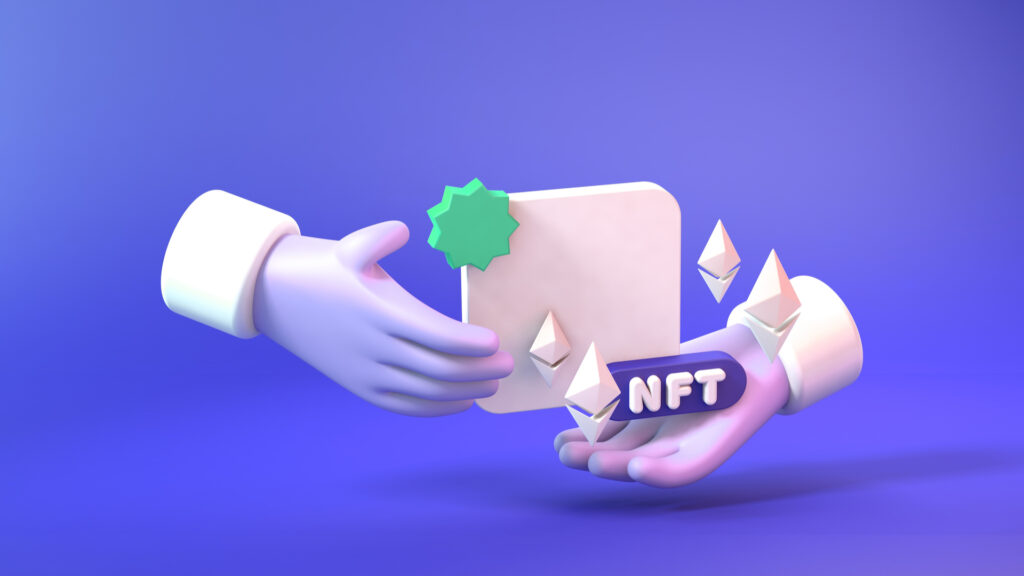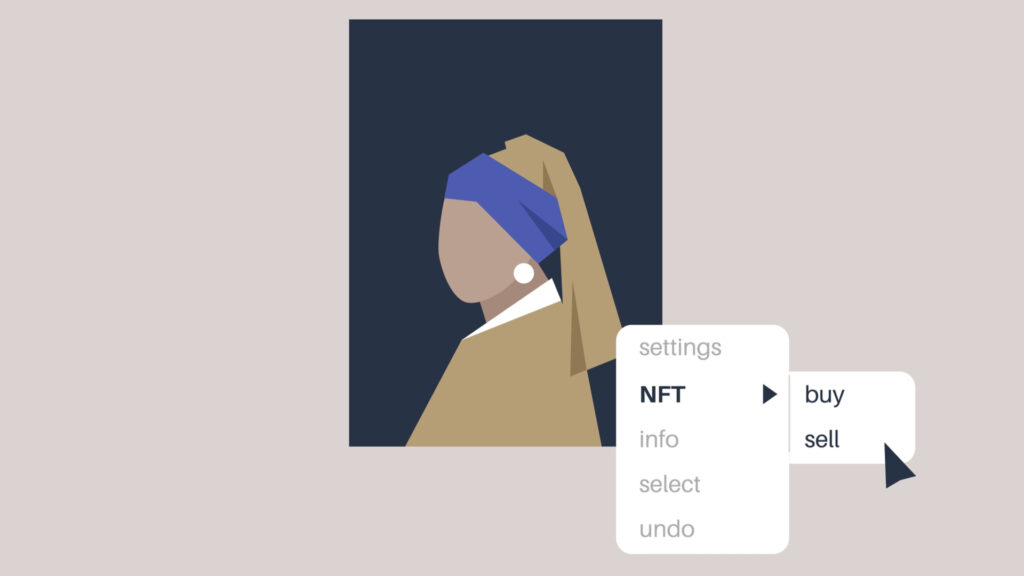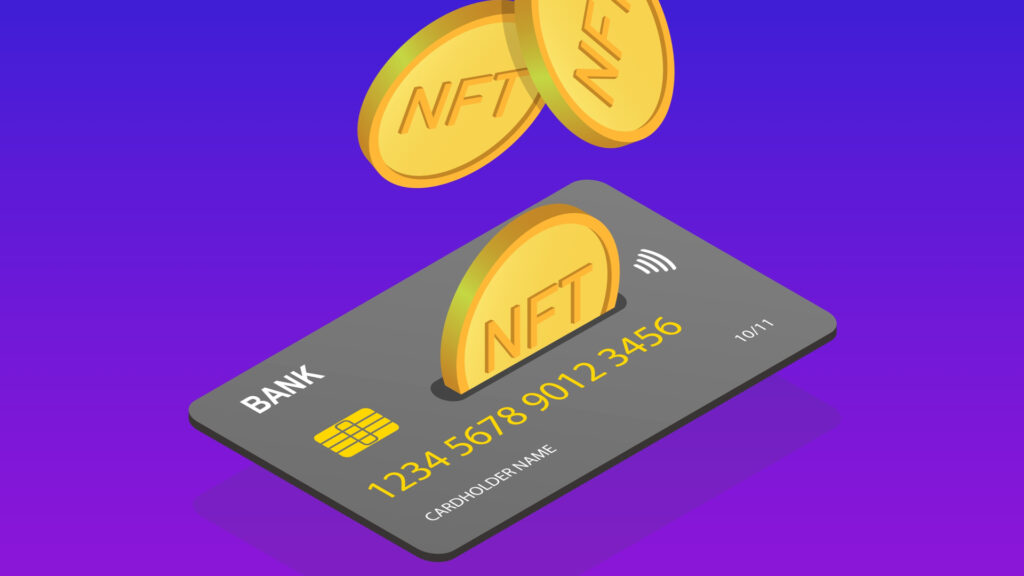What is an NFT, and how does it work? What are NFT examples, and how can you make money from them? The essence and technology of these tokens get explained in this material.
What is an NFT?
NFT stands for a Non-Fungible Token. NFT means that there is only one such unique coin. You can exchange one Bitcoin for another, but this will not work with NFT. It is impossible to exchange one token of this type for another with non-identical characteristics.
These tokens are purchased solely for crypto, and the purchase details get recorded on a blockchain. A blockchain is a chain of blocks, each consisting of information units. These units validate transactions; once they are in the blockchain, you cannot change or tamper with them. NFTs operate under several standards, reducing the cost of transactions and token storage and combining multiple coins into a single contract you can buy. NFTs represent digital art or digital representation of physical assets, whether a painting or a piece of real estate. Right now, the market for non-fungible tokens is centred around NFT art. On special exchanges, you can buy the world's first tweet or a thing for your character in the metaverse.
How do NFTs work?
As we said before, the NFT exists inside of blockchain. The Ethereum blockchain is most often the basis for storing tokens. Art objects, GIFs, videos, collectables, avatars, trainers, and music can become mined NFTs. Once mined, the tokens get placed on a particular NFT marketplace where you can buy them for crypto. Auctions are then held on this website to determine who owns the tokens. After the purchase, the information about the new owner gets recorded in the NFT blockchain. Nevertheless, your name will not appear in the news, even if you buy the world's most expensive or Rarible NFT. Data about buyers get hidden for their own safety, so only the identifiers in the system where the purchase was made are shown.
Why are NFTs valuable?

NFTs are a way of both investing and collecting. If the value of a token increases, you can sell it for a profit to other connoisseurs of digital artefacts. If you want to build a spectacular collection, which will then be moved to the metaverse – outrank everyone in terms of social points. For any self-respecting collector, owning NFTs means being on trend. Therefore, NFTs are a valuable asset used to both earn and emphasise that you belong to a community of enthusiasts who understand the vicissitudes of the crypto market. Still, NFTs need to be sold at the right time because they are unlike standard instruments like stocks and bonds, which you can invest in over several years. So, if you are ready for some risk, non-fungible tokens will be a good investment.
What is NFT art?
NFT art is the same token but in the “art” category. The term is often used to refer to artwork explicitly created for NFT. It could be a 3D model of Eminem or Madonna, a meme, or a large, digitised painting with thousands of pieces.
How to make an NFT
How can you make your own NFT?
- Firstly, come up with a concept for your token. It could be a George Floyd image or a replica of a McDonald's restaurant – it's up to your imagination. Next, make sure you have the rights to the digital artwork.
- Choose the blockchain on which the NFT will be based. The definition and purpose of the blockchain, in this case, is to store a permanent record of the token. The most popular blockchain for NFT is, of course, Ethereum. Next on the list is Solana, a platform that offers low transaction fees and fast payments. Next, there are separate Solana NFT marketplaces, where NFTs created on this blockchain get sold. Third on the list is Flow, a blockchain for NFT-based games and tokens.
- Set up a wallet to store your NFT. Make sure the app supports the blockchain of your choice. The most popular wallets include MetaMask, Coinbase, and Ledger Nano X.
- Pick a platform to host NFTs. NFT drops appear on services like OpenSea, Solanart, the Binance exchange, and crypto.com.
- Create an NFT directly on the platform. Almost every marketplace supports this feature.
- Put the NFT up for sale using the “Sell” button on the platform. It is free of charge in most cases. You will have to pay for the transaction after purchase, but the buyer can also do this.
How to mint an NFT
Minting an NFT is the same as selling tokens. But how do you make an NFT? Get an NFT market account, create your first token, and put it up for sale. You may be charged additionally for the placement, so choose your marketplace carefully. If you don't want to pay for selling your token (there is a fee for this), you can only create it after completing the transaction and send it to the buyer. This operating mechanism is called lazy minting. A rather famous Mintable is among the portals that support it. It allows you to create a “gasless” token, which means you will not get charged for the transaction.
How to create NFT art

To create art, you first need to select an appropriate platform. It can be a curatorial platform (only authorised artists are allowed), like SuperRare, or a self-service platform, where you create your own NFTs, like Rarible. After creating a wallet and picking a service, it is up to you to develop the concept of your NFT. You can do this through the “Collection” service on any platform. Enter a name and description for the collection and separately for the image; upload a photo or video (not the token). Your tokens can be standalone (existing in a single edition) and non-standalone (existing in several editions with different serial numbers). You can calculate the NFT’s price based on the average price for coins with the same characteristics as your coin. To buy NFT, the buyer can either participate in an auction or pay a fixed amount. You also set up this option.
Where to buy and sell NFT art, and how
You can buy NFT art only for cryptocurrency. There are free NFTs, but they are either raffled off or get taken faster than you can blink. Instead, you can buy tokens on exchanges, the names of which we listed earlier in this article. On the marketplace, you will need to enable your cryptocurrency wallet – not create it but connect it to the exchange's system. After registering with the service, you can choose the NFT to buy, participate in auctions, and purchase tokens at a fixed price.
You may be charged a fee for buying and listing, i.e., placing tokens on the exchange (including for the first time). Therefore, please read the platforms' rules carefully before signing up!
NFT marketplaces
Some of the most popular marketplaces are:
- OpenSea. Launched in 2017, it lists digital art, photos, music, maps and virtual worlds. The marketplace uses Ethereum and Solana blockchains. It does not accept payment in fiat currencies. Creating an account is free, but the service charges a 2.5% commission for selling. Nevertheless, there is a Polygon network where you can sell and send your tokens to buyers for free. OpenSea sells NFTs from the World of Women (avatars of girls) and Lazy Lions (avatars of lions).
- Rarible. It's the same as OpenSea, but the list of assets also includes in-game skins. Ethereum and Tezos are accepted, as well as credit cards. The commission is the same – 2.5%. The exchange partners with Adobe, and this makes verifying the metadata of digital content more manageable. On this marketplace, you'll find tokens from invisible friends. They look like GIFs with invisible people in different outfits marching forward. There are also assets from the Bored Ape Yacht Club that you probably know: they are static pictures of a monkey with a grumpy face.
- Binance. In 2021, this cryptocurrency exchange added NFT to its list of traded assets. Overall, the service is no different from other players in the market but charges only a 1% trading commission. Thanks to this, many creators quickly migrated to Binance.
- Nifty Gateway. This marketplace sells works from well-known artists and celebrities. NFTs by Tory Lanez and avatars like the Azuki collection can be found here. Tokens are sold for a limited time after the release, and you can buy them with a credit card.
- SuperRare. Not a service but an art gallery. Only artists are allowed to publish their works – you won't find any memes in the form of tokens here. For the first sale of NFT, the platform charges as much as 15%, which is later reduced to 3%.
- OpenSea. The most popular marketplace where you can find anything. Every self-respecting creator publishes their work on this marketplace as it brings in massive traffic. The site supports Ethereum, Polygon, Klayton Blockchain and Solana blockchains and accepts payment in Ethereum-based tokens. It is a kind of GameStop, but in the art and collecting world: there are many digital art categories and creators. You can buy NFTs of any kind and for any taste here.
Most expensive NFTs

Below we've listed the most expensive NFTs sold and how they differ from one another according to the Rarity Tools portal.
- Beeple, Everydays: The First 5000 Days, $69.3 million. It is a digital asset depicting 5,000 days of the artist who created it. The most expensive NFT was sold at Christie's for a record amount, even by the standards of the luxury industry.
- Julian Assange and Puck, Clock, $52.7 million. It's a token with a timer that runs Julian's time in prison. It was bought by AssangeDAO, an organisation fighting for the freedom of the WikiLeaks founder.
- Beeple, Human One, $28.9 million. The token was sold at Christie's 21st Century auction as a digitised asset and electronic sculpture.
- CryptoPunk #5822, $23.7 million. It is the most expensive CryptoPunk ever sold. The buyer is listed as Deepak Tapliyal, CEO of Chain.
- CryptoPunk #7523, $11.7 million. COVID Alien was sold in 2021 at Sotheby's Natively Digital auction. The sale was seen as a victory in the crypto community: the coin's minter, Straybits and second owner Sillytuna are considered influential members of the crypto world.
- Tpunk #3442, $10.5m. The “Joker” was bought by Justin Sun, the founder of the TRON system, a frequent bidder at Beeple. Interestingly, this collection is super similar to CryptoPunks coins but based on a different blockchain.
- CryptoPunk #4156, $10.2 million. There's a whole history associated with this NFT. The token is believed to have become synonymous with the identity of a famous person in the crypto world. Its sale marked a new era in terms of copyright, about which the coin's creator had a dispute with Larva Labs.
- CryptoPunk #5577, $7.7 million. Compound Finance CEO Robert Leshner allegedly bought this token; after the asset was sold, he wrote a joyful “Yeehaw” on his Twitter account. The token is one of 24 units in the special Monkey NFT collection.
- CryptoPunk #3100, $7.5 million. Another CryptoPunk NFT was bought in 2021 at the last sale of the entire collection of 10 units. The name of the investor who purchased the token is unknown.
- CryptoPunk #7804, $7.5 million. A now influential collector with the nickname Perugue acquired another one of ten such pieces. It is believed that the same investor Robert Leshner may be behind it.
Bored Ape Yacht Club
Bored Ape Yacht Club is an NFT collection featuring the same image of a monkey in different clothes, with different headdresses and different backgrounds. It is still quite popular in the NFT community and sells for extensive cheques. These NFT pictures are being put up on several marketplaces simultaneously, although OpenSea and Rarible remain the leading ones.
NFT games
There are three NFT games currently at the popularity tops:
- Axie Infinity. It's a role-playing game where you must breed and raise pets, creating entire generations of creatures. You can sell rare breeds as NFTs. There are battle and adventure modes so that you won't get bored. The game is free, but you will need to pay to develop your pet quickly. The interface is reminiscent of Disney cartoons, so even a child may like it.
- The Sandbox. It works like Minecraft but allows you to sell and trade your NFTs within the game. You can create an entire metaverse in it and put items from it for sale on a marketplace like VeVe. You can even export your own content to it.
- Gods Unchained. It's a card game with a combat mode. You fight other players and get rewarded for your skills. You can earn cards and experience points and then sell them.
How to invest in NFT
First, research the market. Which NFTs are selling, and for how much? Which assets are in increasing demand? How has it changed over the year? Be rational; in terms of returns, it's the same investment as a more classic exchange but in a new space. Careful analysis is just as necessary here. Next, explore the tokens to be published soon on NFTcatcher. Find out as much information as you can about the team that created the coin and how it is stored. If the token is stored offline, server corruption can cause it to be lost. Next, evaluate the coins you want to buy based on their usefulness, ownership history, future value (you can find predictions on crypto news sites) and liquidity. Some portals have a generator of assumptions about the growth or fall in the value of NFT, so study them before deciding.
Second, choose a service through which you will invest and buy crypto. It may be a classic marketplace from those already listed or something small and niche. You will also need to buy crypto to make a purchase; you can do that on exchanges like Coinbase, Gemini, Kraken, Robinhood, and Binance. If you can afford to pay a crypto broker who will pick the NFT for you, do that. The cryptocurrency must get placed in a wallet connected to a token-selling system.
Third, make the first transaction. The transaction most often involves paying for gas, a special coin used to pay for carrying funds from the buyer to the seller in the Ethereum system. And, of course, don't forget about possible commissions from the marketplace. After the purchase, you can sell your NFT at a profit after some time. Do not keep tokens for several years. It makes no sense because they may depreciate in time.
Why are NFTs bad for the environment?
NFTs themselves have no impact on the environment. However, how they get minted is energy-intensive, as the Proof-of-Work algorithm is typically used to create the token, which works in mining. However, not every coin is based on this algorithm. Still, transferring a non-mining NFT created from one site to another may still require a Proof-of-Work algorithm, which will negatively impact the environment. However, NFT storage is not energy intensive, so at least you can hold your tokens safely and without remorse.
The future of NFTs
The future of NFTs is unclear, but it is interesting. As has been said more than once at one of the most significant events in the field, NFT.NYC, the value of tokens will soon be built on the community around them, the shared culture and utility. The volatile market allows investors to make a lot of money on NFT using specific strategies. Moreover, the tokens are getting more exclusive and exciting: you don't just own a picture but become part of a particular group of like-minded people and get extra bonuses. For example, NFTs are actively used in metaverses, which the founders of the world's leading social media and investment banks that analyse the industry believe in. Indeed, very soon, coins will grant privileges in the virtual world and real life, thus integrating into our everyday lives.